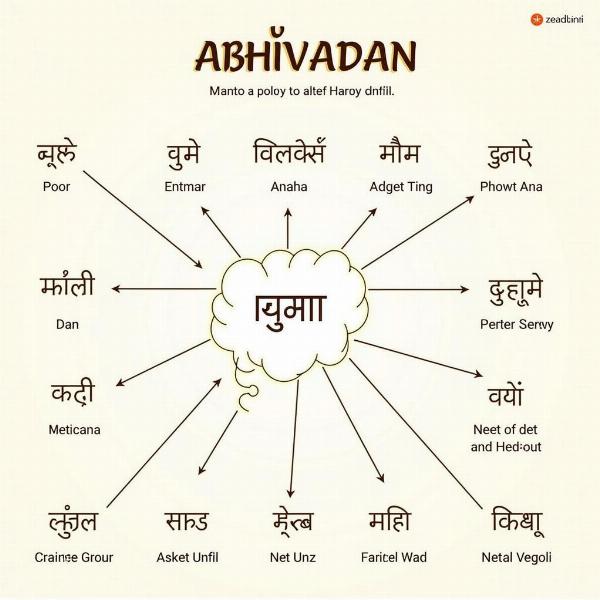Abhivadan in Hindi carries the profound meaning of greeting or salutation. It’s more than just a simple “hello”; it embodies respect, courtesy, and cultural nuances. Understanding the meaning and usage of abhivadan is crucial for navigating social interactions in India.
Decoding the Nuances of Abhivadan
Abhivadan encompasses a range of greetings, from formal to informal, reflecting the diverse Indian social fabric. While “Namaste” is perhaps the most globally recognized form of abhivadan, numerous other expressions exist, each with its own specific context and significance. The choice of greeting depends on factors like the time of day, the relationship between individuals, and regional customs. For instance, “Pranam” conveys deep respect, often used towards elders or revered figures. “Ram Ram” is a common greeting among Hindus, particularly in North India.
Abhivadan in Indian Culture and Traditions
Abhivadan is deeply intertwined with Indian culture and traditions. It reflects the values of respect, humility, and social harmony. From ancient scriptures to everyday interactions, abhivadan plays a vital role in shaping social etiquette. In Hinduism, abhivadan is considered a sacred act, acknowledging the divine presence within each individual. It is believed that a proper abhivadan can create positive energy and foster good relationships.
Formal vs. Informal Abhivadan
Understanding the distinction between formal and informal abhivadan is essential for effective communication. Formal greetings are typically reserved for elders, superiors, or strangers. Informal greetings are used among friends, family, and peers. Using the wrong form of abhivadan can be perceived as disrespectful or inappropriate.
Abhivadan: Beyond Words
Abhivadan is not limited to verbal expressions; it also encompasses gestures and body language. The folded hands in “Namaste,” for example, symbolize respect and unity. A slight bow of the head or a gentle touch of the feet can also convey reverence and humility. These non-verbal cues play a crucial role in conveying the true meaning of abhivadan.
How to Use Abhivadan Appropriately
Choosing the appropriate abhivadan can sometimes be challenging, especially for those unfamiliar with Indian customs. A general rule of thumb is to err on the side of formality when interacting with elders or those in positions of authority. Observing and learning from others is also a valuable way to master the art of abhivadan.
What does abhivadan literally mean?
Abhivadan literally translates to “greeting” or “salutation.”
What are some common examples of abhivadan?
Common examples include “Namaste,” “Pranam,” “Ram Ram,” “Radhe Radhe,” and “Jai Shri Krishna.”
Why is abhivadan important in Indian culture?
Abhivadan signifies respect, courtesy, and cultural understanding. It fosters positive interactions and strengthens social bonds.
How do I choose the right abhivadan?
Consider the context, your relationship with the person you are greeting, and regional customs.
Is there a difference between formal and informal abhivadan?
Yes, formal greetings are used for elders and superiors, while informal greetings are reserved for friends and family.
 Examples of Abhivadan
Examples of Abhivadan
Conclusion
Abhivadan is an integral part of Indian culture, reflecting values of respect and social harmony. Understanding its nuances can enhance your interactions and deepen your appreciation for Indian traditions. By embracing the art of abhivadan, you can foster meaningful connections and navigate social situations with grace and respect.
FAQ
- What is the most common form of abhivadan? Namaste is the most common and widely recognized form.
- Is “Good Morning” an acceptable abhivadan? Yes, “Good Morning” and other English greetings are becoming increasingly common, especially in urban areas.
- Can I use abhivadan in formal settings? Absolutely, certain forms of abhivadan, like “Pranam,” are specifically used in formal settings.
- What should I do if I’m unsure which abhivadan to use? It’s always best to err on the side of formality.
- Is abhivadan only used in Hinduism? While prominent in Hinduism, abhivadan is a cultural practice observed across various religions and communities in India.
- Are there regional variations in abhivadan? Yes, different regions have their own unique greetings and customs.
- Can I use gestures along with abhivadan? Yes, gestures like folded hands or a slight bow enhance the meaning of abhivadan.
Meaning-Hindi.in is your trusted partner for accurate and culturally sensitive Hindi translation services. We specialize in various domains, from business and legal documents to technical manuals and website localization. Our expert team ensures your message is conveyed effectively while respecting cultural nuances. Need help with translating your documents? Contact us at [email protected] or call us at +91 11-4502-7584. Meaning-Hindi.in understands the importance of precise and culturally appropriate communication in a diverse global landscape.